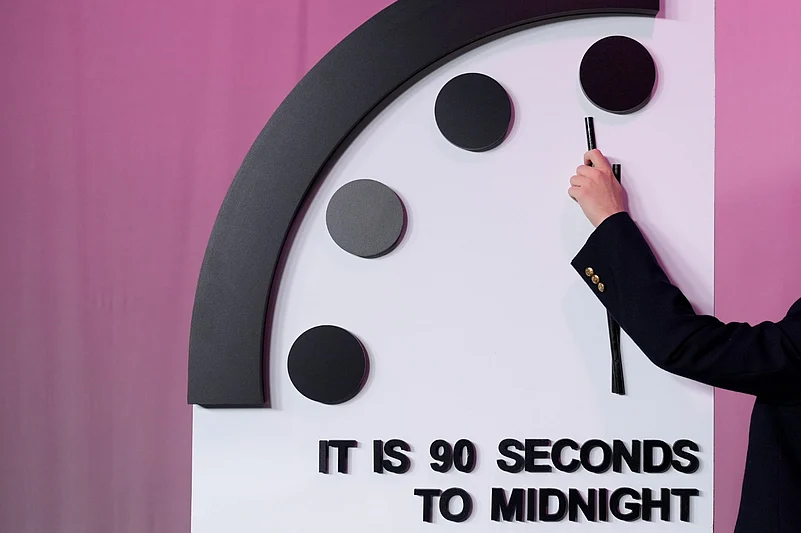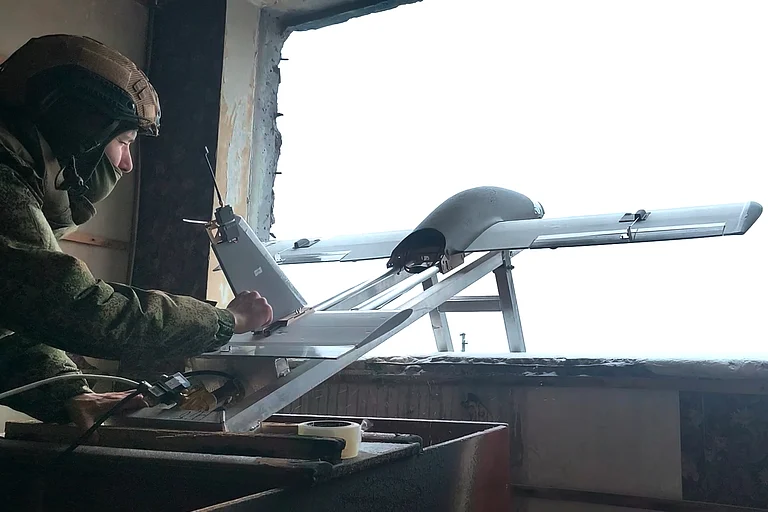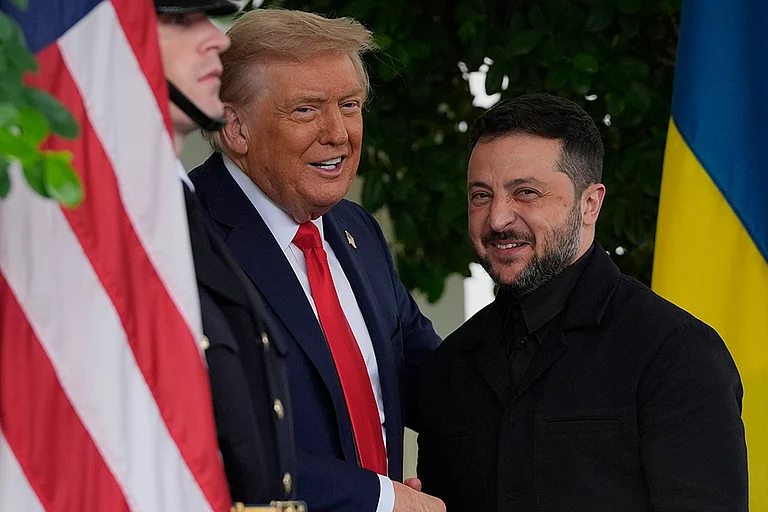The 'Doomsday Clock' is set 90 seconds to midnight, which is the closest it has ever been to midnight, according to the Bulletin of the Atomic Scientists.
The scientists at the Bulletin, which runs the Doomsday Clock, decided to retain it at 90 seconds to midnight for 2024. They had first set the clock to 90 seconds to midnight last year as the war in Ukraine raged with no end in sight and the climate crisis continued to ravage the world.
The Doomsday Clock refers to how close we are to the end of the world. The 'midnight' is the symbol of apocalypse and the clock symbolises the countdown to such an apocalyptic moment that the world is heading towards from disruptive events like wars, arms race, and climate crisis.
The scientists at the Bulletin say the world currently faces an "unprecedented level of danger" and the world's leaders should respond to the crises as if they were facing the "most dangerous moment in modern history".
Here we explain what's the Doomsday Clock, why it was established, and how scientists manage it.
What's 'Doomsday Clock'?
The 'Doomsday Clock' is a clock maintained by the Bulletin of Atomic Scientists that's dedicated to the symbolic countdown to the extinction of humanity.
For this year, the scientists running the Doomsday Clock kept it at 90 seconds to midnight, the closest it has ever been to midnight. The clock was set to 90 seconds last year amid the climate crisis and Ukraine War.
The Doomsday Clock is run by the Bulletin, founded in 1945 by top scientists of the time like Albert Einstein and J Robert Oppenheimer along with other University of Chicago scientists who helped develop the first atomic weapons in the Manhattan Project. Two years later, the Bulletin set up the Doomsday Clock in the shadows of nuclear weapons that had raised to fears of an apocalyptic event borne out of an arms race, geopolitical tensions, and miscalculations in wars and battles.
The scientists created the Doomsday Clock to use the 'midnight', imagery of apocalypse, and the contemporary idiom of nuclear explosion, the countdown to zero, to convey threats to humanity and Earth and indicate how close the world stood to a catastrophe that could cause its end.
In 1947, the Doomsday Clock was set seven minutes to midnight. The farthest it came was 17 minutes to midnight in 1991 when the Cold War ended with the collapse of the Soviet Union. A series of developments since then, primarily nuclear proliferation and wars and conflicts, worked together to drive the clock 90 seconds to midnight last year. This year, the Bulletin retained it.
The Bulletin's Science and Security Board sets the clock every year in consultation with its Board of Sponsors, which includes nine Nobel laureates.
The Doomsday Clock has become a universally recognised indicator of the world's vulnerability to global catastrophe caused by human-made technologies, said the Bulletin in a statement on Thursday.
"The Bulletin focuses on three main areas: nuclear risk, climate change, and disruptive technologies. What connects these topics is a driving belief that because humans created them, we can control them," says the Bulletin further on its website.
Why Is 'Doomsday Clock' Set 90 Seconds To Midnight?
The 'Doomsday Clock' was set 90 seconds to midnight in January 2023. This year, the Bulletin of Atomic Scientists retained that setting.
The 90 seconds —1 minute and 30 seconds— is a far cry from the 17 minutes that the Doomsday Clock had been set in 1991 at the end of the Cold War in what was the farthest setting of the clock from the midnight. The current setting of the clock indicates how deep the world has moved into dangerous and uncertain times.
The Doomsday Clock is not intended to serve as "a forecasting tool" and does not predict the future, but it is a symbol of threats to humanity and each second does not represent how many years or decades the world is from apocalypse, notes The New York Times.
The Bulletin said the world currently faces an "unprecedented level of danger" and the world's leaders should respond to the crises as if they were facing the "most dangerous moment in modern history". The "unprecedented danger" is credited to the ever-growing risk of nuclear escalation from the war in Europe, the widening conflict in the Middle East, the climate crisis, and the rise of disruptive technologies like the artificial intelligence.
"Ominous trends continue to point the world toward global catastrophe. The war in Ukraine and the widespread and growing reliance on nuclear weapons increase the risk of nuclear escalation. China, Russia, and the United States are all spending huge sums to expand or modernize their nuclear arsenals, adding to the ever-present danger of nuclear war through mistake or miscalculation," said the Bulletin in the statement on Thursday.
The statement further read, "In 2023, Earth experienced its hottest year on record, and massive floods, wildfires, and other climate-related disasters affected millions of people around the world. Meanwhile, rapid and worrisome developments in the life sciences and other disruptive technologies accelerated, while governments made only feeble efforts to control them."
Isn't It Good That 'Doomsday Clock' Remains At 90 Seconds?
While the retaining of the clock at 90 seconds might at first appear as a consolation that the world has not got any worse, the Bulletin said that's not the case. The fact that the clock was not backward reflects the "continued state of unprecedented danger the world faces", said the Bulletin.
The Bullet's President and CEO Rachel Bronson said: "Make no mistake: resetting the Clock at 90 seconds to midnight is not an indication that the world is stable. Quite the opposite. It's urgent for governments and communities around the world to act. And the Bulletin remains hopeful—and inspired—in seeing the younger generations leading the charge."
The three broad reasons why the Bulletin assesses the world is the closest it has ever been to a catastrophe are the highest-ever fear of a global nuclear escalation amid wars in Ukraine and Middle East; Russia abandoning nuclear treaties; growth of nuclear spending and arsenals; worsening climate change and the lack of appropriate reduction in fossil fuel usage; and dangers of misuse of unregulated disruptive technologies like the artificial intelligence (AI).
Besides Russia's threats of using nuclear weapons against Ukraine, the Bulletin in its Thursday's statement also mention the rising nuclear spending by the United States, China, and Russia and a "three-way nuclear arms race as the world’s arms control architecture collapses".
"Russia and China are expanding their nuclear capabilities, and pressure mounts in Washington for the United States to respond in kind," says the statement.
The Bulletin further noted that Iran continues to enrich uranium close to the level needed for nuclear weapons and North Korea also continues to develop weapons. It also mentioned India and Pakistan continuing to develop nuclear weapons.
The Bulletin further says the ongoing war in Gaza has "has the potential to escalate into a wider Middle Eastern conflict that could pose unpredictable threats, regionally and globally".
The onus of solving the world's crisis, which drove the Doomsday Clock to 90 seconds to midnight, is with the United States, China, and Russia, says the Bulletin, adding that the three countries should engage on issues like climate change, nuclear arms race, AI, and geopolitical tensions to stabilise the world.
"As the first step, and despite their profound disagreements, three of the world’s leading powers—the United States, China, and Russia—should commence serious dialogue about each of the global threats outlined here. At the highest levels, these three countries need to take responsibility for the existential danger the world now faces. They have the capacity to pull the world back from the brink of catastrophe. They should do so, with clarity and courage, and without delay," says the Bulletin.


























